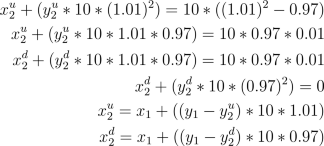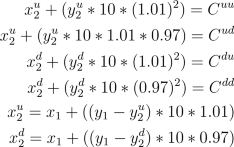Hedging is refered to as the
practice of finding hedges and falls into the
framework of risk management. A hedge is an
investment used to reduce or cancel out the risk taken in another
investment.
In the previous lesson we mentioned that Financial Derivatives are
instruments used by investors to reduce the risk in the market. In this
lesson we make this statement more clear through some examples. Before
reading the material of this section it is recommended to review the
notation and concepts of the
arbitrage
opportunities lesson.
Example 4
Suppose that an investor is facing the market described in the last
part of the
previous
lesson. In this market, under the risk-neutral probability
measure, the price of the stock is more likely to go up than down. Call
options on the stock reduce the risk of an investor who wants to buy in
two days, since it is very likely that the price in two days is going
to be higher. As we saw for a strike price of 10*0.97 the price of the
call option with maturity of two days is 0.3181875
Now you can imagine that the seller of the call option would be
interested in having a strategy to cover the call option. One simple
possibility comes from the put-call parity and corresponds to buying a
forward contract with the same forward price and a European put option
with the same strike and maturity. Another less simple alternative
corresponds to finding a strategy in the money market account and risky
asset. In this case the seller wants to find a self-financing strategy
(x,y)
such that the value of the final portfolio is equal to the payoff of
the call option. In order to find such a strategy he will have to solve
the following system of linear equations

The last two equations account for the self-financing condition (see
last note in
arbitrage
opportunities). The unique solution to this system is
approximately
x1=-7.8631, y1=0.8181,
x2d=-2.3523, y2d=0.25,
x2u=-9.7, y2u=1.
Since in this case the system of equations has an exact solution we
call the trading strategy
(x,y) a
perfect
hedge or
replicating strategy
for a European call option with maturity of two days and strike
10*0.97. Observe that the initial portfolio corresponds to borrowing
approximately 7.8631 in money and buying 0.8181 shares of the stock.
The value of this initial portfolio is approximately 0.32, the price of
the European call option. This is not a coincidence and can be
generalized for any perfect hedge.
Proposition
If the self-financing portfolio
(x,y) is a perfect
hedge of a contingent claim with final payoff
C,
the value of the initial portfolio
(x1,y1)
is equal to the arbitrage free price of the claim,
EQ*[C/(1+r)T].
Here,
Q* is any risk-neutral
probability measure.
Note
The procedure described in Example 4 above shows how to hedge or
replicate a European call option with maturity of 2 days and strike
equal to 10*0.97 by using the money market account and the risky asset.
This method can be generalized to any contingent claim and in
particular to any Financial Derivative. Let
Cuu,
Cdu, Cud and Cdd
be the payoffs when the price goes up both of the days, goes up the
first day and down the second day, goes down the first day and up the
second day and goes down both days, respectively. Then finding a
perfect hedge,
(x,y) for this claim corresponds to
solving the following system of six linear equations with six unknowns,
x1, y1,
x2d, y2d,
x2u, y2u,

It is a known result of linear algebra that if a system like this has a
unique solution
for some values of
Cuu,
Cdu, Cud and Cdd
then it has a solution
for any Cuu,
Cdu, Cud and Cdd.
Hence, since we could find a perfect hedge for a European call option
we can find a pefect hedge for any contingent claim. When the latter
holds we say that the market consisting of the money market account and
the risky asset is a
Complete Market. In our model
the market completeness is an immediate consequence of the fact that
the risk-netral measure
Q*
is unique and the following theorem.
The Second Fundamental Theorem of Asset Pricing
A market is complete, i.e any contingent claim can be perfectly hedged,
if and only if, there exists a unique risk-neutral probability measure
in the market.
Further Analysis
Up to this point we have seen the conditions under which the CRR model
with only one risky asset is arbitrage-free. We saw that if these
conditions are satisfied then the market is complete and the
arbitrage-free price of any contingent claim is the value of the
initial portfolio of any replicating strategy or perfect hedge. All
this questions become more interesting when we modify our assumptions
and we allow more than one risky asset in the market, more than two
rates of return at any time and we put constraints to the
self-financing strategies, e.g. if short-selling is not allowed or is
bounded below by a fix quantity. This elucidates the level of
complexity reached by Financial Markets from the mathematical point of
view.
Activities
- Consider the CRR model of Example
2 with rate of interest r=0.05. Explain
why this model is arbitrage-free. Find a perfect hedge for a European
put option with maturity of one day and strike price equal to 1.5.
- Consider the CRR model of Example
3 with rate of interest r=0. Find a
perfect hedge for a straddle with maturity of one day (see activity a)
of the previous
lesson).
- You want to sell a bottle of
wine to a friend of yours who has a
romantic dinner with a date tomorrow. The price of the bottle today is
$30. You know that this price either goes up by %10 percent or down by
%50 with the same probability. You can borrow or lend money with no
interest rate. You agreed with your friend that tomorrow he will pay
the minimum between the price tomorrow and the current price. How much
should you charge your friend for this? How would you hedge your
position?